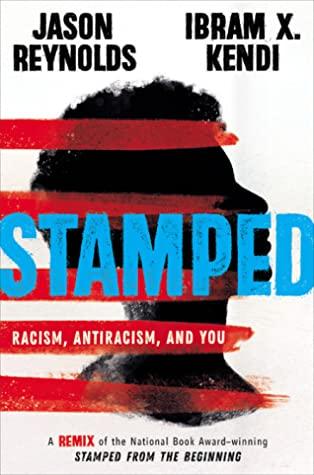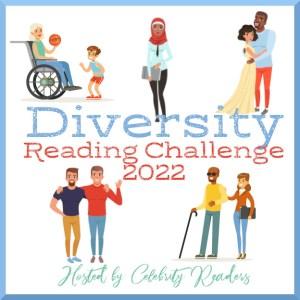Book: Stamped: Racism, Antiracism, and You by Jason Reynolds and Ibram X. Kendi
Genre: Young Adult
Publisher: Little, Brown and Company
Publication date: 2020
Pages: 294
Source: Print book borrowed from the library
 Summary: Ibram X. Kendi writes in the introduction about how this book relates to his book for adult readers, Stamped from the Beginning:
Summary: Ibram X. Kendi writes in the introduction about how this book relates to his book for adult readers, Stamped from the Beginning:
The novelist Jason Reynolds adapted Stamped from the Beginning into this book for you. I wish I learned this history at your age.... Jason is one of the most gifted writers and thinkers of our time. I don't know of anyone who would have been better at connecting the past to the present for you. Jason is a great writer in the purest sense. A great writer snatches the human eye in the way that a thumping beat snatches the human ear, makes your head bob up and down. It is hard to stop when the beat is on. A great writer makes my head bob from side to side. It is hard to stop when the book is open. (p. x)
To reassure young readers who may or may not like history, Jason Reynolds starts with this:
Before we begin, let's get something straight. This is not a history book.... At least not like the ones you're used to reading in school.... Instead, what this is, is a book that contains history. A history directly connected to our lives as we live them right this minute. This is a present book. A book about the here and now. A book that hopefully will help us better understand why we are where we are as Americans, specifically as our identity pertains to race. (pp. 1-2)
Right at the beginning Reynolds gives readers a structure to help us understand the people that we're going to encounter in a timeline that begins in 1415 with "The Story of the World's First Racist" (that's the title of Chapter 1) and goes to the present day - and, really, to the future in the acknowledgment that young readers can take what they learn in this book and other books to change the world. Here's the structure:
Oh! And there are three words I want you to keep in mind. Three words to describe the people we'll be exploring:
Segregationists. Assimilationists. Antiracists.
There are serious definitions to these things, but...I'm going to give you mine.
Segregationists are haters. Like, real haters. People who hate you for not being like them. Assimilationists are people who like you, but only with quotation marks. Like..."like" you. Meaning, they "like" you because you're like them. And then there are antiracists. They love you because you're like you. But it's important to note, life can rarely be wrapped into single-word descriptions. It isn't neat and perfectly shaped. So sometimes, over the course of a lifetime (and even over the course of a day), people can take on and act out ideas represented by more than one of these three identities. Can be both, and. Just keep that in mind as we explore these folks. (p. 4)
Those words apply to people regardless of race. The single person who gets the most coverage in this book is W. E. B. Du Bois. His long career gave him lots of time to be both an assimilationist and an antiracist, "over the course of a lifetime."
Before we get to Du Bois, though, we learn about the people and ideas that took us from early colonized America through the Civil War and Reconstruction.
Reynolds began with Harvard University. The first university in what would one day be the United States was founded on the Puritan and Aristotelian belief in human hierarchy.
According to the Puritans, they were better than:
- Native Americans.
- Anglican (English) people who weren't Puritans
- Everyone else who wasn't a Puritan.
- Especially African people.
And guess what they did during the development of Harvard? They made it so that Greek and Latin texts could not be disputed. Which meant Aristotle, a man who believed in human hierarchy and used climate to justify which humans were better, could not be disputed, and instead had to be taken as truth.
And just like that, the groundwork was laid not only for slavery to be justified but for it to be justified for a long, long time, simply because it was woven into the religious and educational systems of America. (pp. 16-17)
With that foundation of hierarchy, we learn about rebellion (a natural response to an unnatural hierarchy) and revolution and civil war. Chapter 10, "The Great Contradictor," is about Thomas Jefferson. Chapter 13 gives us "Complicated Abe" because Honest Abe is way too simplified, even for young adults.
We learn about how when antiracist ideas come to the forefront and when black individuals excel, the culture (rooted in that hierarchy that permeated religious and intellectual ideas) fights back. We get the great boxer Jack Johnson and when the "Great White Hope" can't beat him - the system conspires to arrest Johnson and fights back with Tarzan, a white man who, over and over again, "protects a White woman named Jane from being ravished by Africans." (p. 133) When black soldiers return from World War I, naturally thinking that they ought to be treated as well at home as they were in France, they were met with the Red Summer. We get Brown v. Board of Education and a year later Emmett Till, a fourteen-year-old boy, is beaten to death. Dr. Martin Luther King, Jr tells the world about his dream and less than a month later four black girls are killed in a bombing of a church.
This is when Angela Davis appears on the scene. She's from Birmingham, where the church was bombed. Davis is a thread woven through the final seven chapters of the book, covering the deaths of Malcolm X and Dr. King, the Black Power movement, the war on drugs that wasn't, and the birth of hip-hop. I scheduled this post for today because it's the 50th anniversary of her release on bail from jail - to be acquitted of all charges a few months later.
Science brought a moment that might have accelerated change.
Want to know something incredible? And strange? And both surprising yet not surprising at all?
Scientific evidence that the races are 99.9 percent the same was brought forth on June 26, 2000. The year 2000 was when people were given scientific evidence that human beings were the same, despite the color of their skin. Isn't that wild?
Bill Clinton delivered the news as if it were news. (p. 227)
Just as the world was organizing itself with a conference to start a global antiracist movement, we got distracted by September 11, 2001.
The final chapter, that begins with Barack Obama and ends with #BlackLivesMatter and #SayHerName, is called "A Miracle and Still a Maybe."
Speaking of hashtags, Jason Reynolds points out in the acknowledgments that hashtags will never be enough. Most of his acknowledgment is devoted to young people where he encourages them to learn more (because it's dangerous to attack something you don't know) and to participate, to be active antiracists.
Thoughts: This book was the Black History Month selection of the Community for Understanding and Hope Book Group - we specialize in books about race in America. We've been reading books together since the summer of 2008. Stamped is the 124th book we've read.
We picked it because Stamped caused an uproar in one of our local school districts when it was used for a One District, One Book program - a backlash so great that the woman who led the program was harassed out of her job. I know and admire and respect that woman.
Given that background, it's hard for me to separate my thoughts about Stamped from my thoughts surrounding the controversy about this book. I wasn't the only one. We spent a lot of time during our discussion talking about why Stamped gets banned. It was second on the American Library Association's list of banned books in 2020, the year that it was published.
From what we can tell, the backlash to this book is rooted in the fear that it will make white children feel uncomfortable and ashamed of being white. A black member of our group pointed out, eventually (because none of us white folks manage to say this), that the natural response to the stated concern is "Where's the outrage for the black children?" Black children have been made to feel uncomfortable in education settings and ashamed of being black for generations. And it hasn't stopped.
So, instead of rehashing all the arguments and concerns, I want to celebrate Stamped. Banning won't undo the existence of this book. I shared a bunch of quotes, but the quotes don't capture the beauty of the narrative flow, the way some passages are poems and others are bolded to emphasize things in a musical way, and the love that permeates through this book to the young people who read it.
Stamped doesn't shame young people of any race. It empowers and challenges young people, and all of us, to build an antiracist America. And that may be the true root of the controversy.
 Appeal: Read Stamped, no matter what your age. If you grew up, as I did, with subtle and not-so-subtle teachings that color blindness is the correct approach to race, then there are some things that we need to unlearn in order to understand Stamped. Color blindness said "that the way to fix racism was to stop focusing on it." (p. 224) But it didn't work. All that color blindness did for us was to make it harder to talk about race. Meanwhile, our societal systems and structures (that were initially built to be racist and were never dismantled) continued to produce racist outcomes. If we want to produce outcomes that live up to the American promise of equality, we'll need to dismantle and rebuild those systems and structures with an antiracist foundation.
Appeal: Read Stamped, no matter what your age. If you grew up, as I did, with subtle and not-so-subtle teachings that color blindness is the correct approach to race, then there are some things that we need to unlearn in order to understand Stamped. Color blindness said "that the way to fix racism was to stop focusing on it." (p. 224) But it didn't work. All that color blindness did for us was to make it harder to talk about race. Meanwhile, our societal systems and structures (that were initially built to be racist and were never dismantled) continued to produce racist outcomes. If we want to produce outcomes that live up to the American promise of equality, we'll need to dismantle and rebuild those systems and structures with an antiracist foundation.
Challenges: Stamped is the first of five books that I challenged myself to read for the 2022 Diversity Reading Challenge.
Have you read this book? What did you think?


About Joy Weese Moll
a librarian writing about books
